Related Research Articles

A barangay, historically referred to as barrio, is the smallest administrative division in the Philippines and is the native Filipino term for a village, district, or ward. In metropolitan areas, the term often refers to an inner city neighborhood, a suburb, or a suburban neighborhood. The word barangay originated from balangay, a type of boat used by a group of Austronesian peoples when they migrated to the Philippines.

Calabarzon, formally known as the Southern Tagalog Mainland, is an administrative region in the Philippines, designated as Region IV-A. The region comprises five provinces: Batangas, Cavite, Laguna, Quezon, and Rizal and one highly urbanized city, Lucena. The region is the most populous region in the Philippines according to the Philippine Statistics Authority, having over 14.4 million inhabitants in 2020, and is also the country's second most densely populated after the National Capital Region.
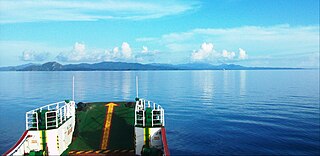
Marinduque is an island province in the Philippines located in Southwestern Tagalog Region or Mimaropa, formerly designated as Region IV-B. Its capital is the municipality of Boac. Marinduque lies between Tayabas Bay to the north and Sibuyan Sea to the south. It is west of the Bondoc Peninsula of Quezon province; east of Mindoro Island; and north of the island province of Romblon. Some parts of the Verde Island Passage, the center of the center of world's marine biodiversity and a protected marine area, are also within Marinduque's provincial waters.
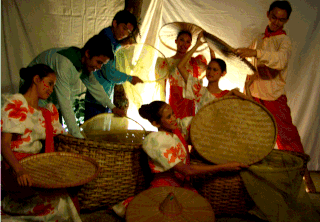
The culture of the Philippines is characterized by cultural diversity. Although the multiple ethnic groups of the Philippine archipelago have only recently established a shared Filipino national identity, their cultures were all shaped by the geography and history of the region, and by centuries of interaction with neighboring cultures, colonial powers. In more recent times, Filipino culture has also been influenced through its participation in the global community."

Los Baños, officially the Municipality of Los Baños, is a 1st class municipality in the province of Laguna, Philippines. According to the 2020 census, it has a population of 115,353 people.

Ternate, officially the Municipality of Ternate, is a 4th class municipality in the province of Cavite, Philippines. According to the 2020 census, it has a population of 24,653 people.

Balayan, officially the Municipality of Balayan, is a 1st class municipality in the province of Batangas, Philippines. According to the 2020 census, it has a population of 95,913 people.
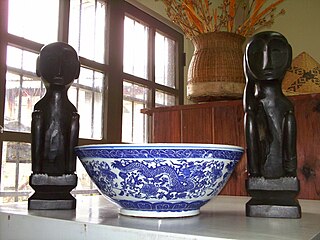
Indigenous Philippine folk religions are the distinct native religions of various ethnic groups in the Philippines, where most follow belief systems in line with animism. Generally, these indigenous folk religions are referred to as Anitism or Bathalism or the more modern and less Tagalog-centric Dayawism. Around 0.2% of the population of the Philippines were affiliated with the so-called "tribal religions", according to the 2010 national census.

Philippine Hokkien is a dialect of the Hokkien language of the Southern Min branch, primarily spoken vernacularly by Chinese Filipinos in the Philippines, where it serves as the local Chinese lingua franca, primarily spoken as an oral language, within the overseas Chinese community in the Philippines and acts as the heritage language of a majority of Chinese Filipinos. The use of Hokkien in the Philippines is influenced by Philippine Spanish, Filipino (Tagalog) and Philippine English.

The Tagalog people are the second largest ethnolinguistic group in the Philippines after the Visayan people, numbering at around 30 million. An Austronesian people, the Tagalog have a well developed society due to their cultural heartland, Manila, being the capital city of the Philippines. They are native to the Metro Manila and Calabarzon regions of southern Luzon, as well as being the largest group in the provinces of Bulacan, Bataan, Zambales, Nueva Ecija and Aurora in Central Luzon and in the islands of Marinduque and Mindoro in Mimaropa.
Resil Buagas Mojares is a Filipino historian and critic of Philippine literature best known as for his books on Philippine history. He is acclaimed by various writers and critics as the Visayan Titan of Letters, due to his immense contribution to Visayan literature. He was recognized in 2018 as a National Artist of the Philippines for Literature - a conferment which represents the Philippine state's highest recognition for artists.
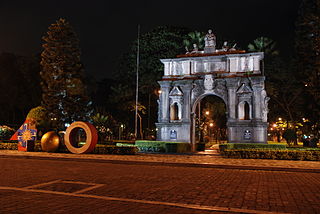
The Arch of the Centuries is a triumphal arch at the Plaza Intramuros of the University of Santo Tomas (UST) in Manila, in the Philippines that stands meters away from the university's Millennium Gate along España Boulevard. Half of the current structure, the side facing the UST Main Building is the ruins of the original Intramuros arch while the side that faces España Boulevard is a replica. The arch was formerly the original entrance to the university when the campus was still in Intramuros during the years from 1680 to 1941. It was declared by the National Museum as a National Cultural Treasure on 25 January 2010.
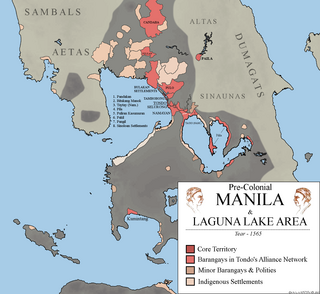
In early Philippine history, the Tagalog settlement at Tondo was a major trade hub located on the northern part of the Pasig River delta, on Luzon island.

Emory J. Tolbert is an American historian, educator, and activist. His scholarship centers on Marcus Garvey and Garveyism, as well as wider aspects of African American history.

The history of the Philippines between 900 and 1565 begins with the creation of the Laguna Copperplate Inscription in 900 and ends with Spanish colonisation in 1565. The inscription records its date of creation in the year 822 of the Hindu Saka calendar, corresponding to 900 AD in the Gregorian system. Therefore, the recovery of this document marks the end of prehistory of the Philippines at 900 AD. During this historical time period, the Philippine archipelago was home to numerous kingdoms and sultanates and was a part of the theorised Indosphere and Sinosphere.

In early Philippine history, the Barangay is the term historically used by scholars to describe the complex sociopolitical units which were the dominant organizational pattern among the various peoples of the Philippine archipelago in the period immediately before the arrival of European colonizers.

Indigenous Philippine shrines and sacred grounds are places regarded as holy within the indigenous Philippine folk religions. These places usually serve as grounds for communication with the spirit world, especially to the deities and ancestral spirits. In some cases, they also function as safeguards for the caskets of ancestors, as well as statues or other objects depicting divine entities.

Bungad is an administrative division in eastern Metro Manila, the Philippines.

Dawn Bohulano Mabalon was an American academic who worked on documenting the history of Filipino Americans. Mabalon was born in Stockton, and earned her doctoral degree from Stanford University; she later taught at San Francisco State University. Mabalon was the co-founder of The Little Manila Foundation, which worked to preserve Little Manila in Stockton, California. During her life, her work elevated the topic of the history of Filipino Americans, in Central California in particular.
References
- 1 2 "UCLA Asia Pacific Center: Damon L. Woods (Profile)". www.international.ucla.edu. Los Angeles, California: UCLA Asia Pacific Center. 2007-06-25. Retrieved 2017-09-15.
- ↑ Quezon, Manolo (2017-10-02). "The Explainer: Bamboozled by the barangay". ABS-CBN News. Archived from the original on 2017-10-02. Retrieved 2017-10-04.
- ↑ Woods, Damon L. (2017). The Myth of the Barangay and Other Silenced Histories. Diliman, Quezon City, Philippines: University of the Philippines Press. ISBN 9789715428217.
- ↑ Werth, Brenda; Becker, Florian Nikolas; Hernández, Paola (2013-01-08). Imagining Human Rights in Twenty-First Century Theater: Global Perspectives. Palgrave Macmillan. ISBN 9781137027092.
- ↑ "UST PUBLISHING HOUSE RELEASES BOOKS BY AND ABOUT TOMAS PINPIN". publishinghouse.ust.edu.ph. Retrieved 2017-09-15.